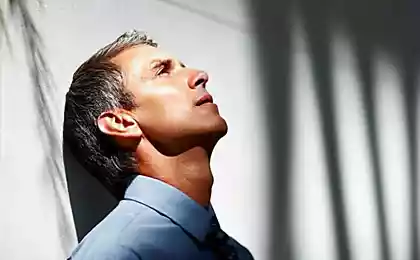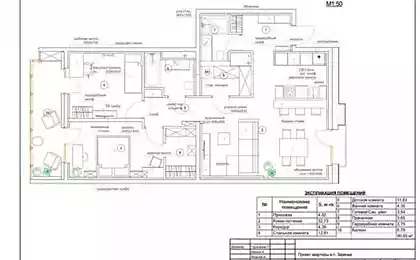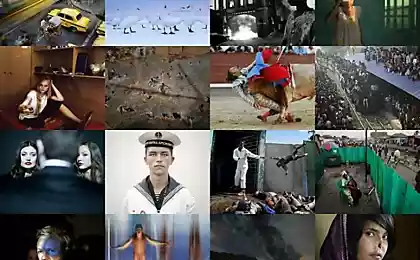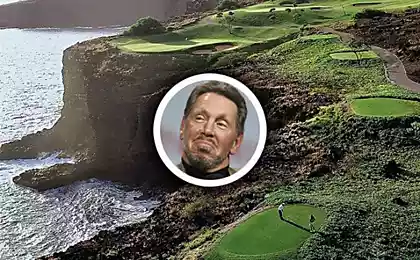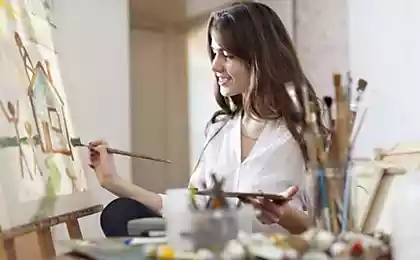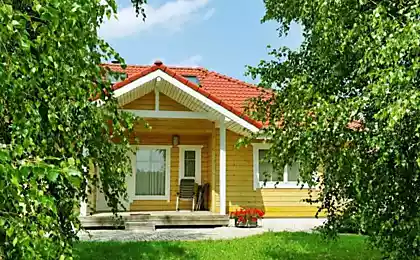596
5 most eco-friendly hobby
Most fashionable entertainment requires a significant investment – you need again and again to buy expensive equipment and supplies. But there are also very eco-friendly hobby that will not only give the opportunity to be creative, but also reduce unnecessary consumption. The boxed life

Japanese designer, Masahiro Mine has created a series of products for children Uchinoco of the conventional corrugated cardboard. Houses and tractors almost life-size, toys and beds assembled like origami from the cardboard, which in our country is most often used for the production boxes. Masahiro not alone in his fondness for this unusual material. American design firm has developed a series of furniture SmartDeco for lovers of frequent travellers: dresser, Desk, chair, shelves and a bookcase. This furniture can withstand weight up to 180 kg and carry it can be disassembled and folded stack. The manufacture of cardboard furniture is not a difficult task as it might seem at first glance. Start simple: watch, box, house for cats, a stool for the kitchen... on the Internet there are communities of fans of cardboard products on their sites already collected a large number of patterns and layouts of furniture for every taste. Cardboard is a durable material, and if it is painted with acrylic paints, paste and decorate, you will become the owner of a unique interior. In the world is used daily by so many packaging materials, including cardboard is one of the first places that a cardboard hobby can be considered one of the most environmentally friendly in our ranking. Warm world

Wool, soap and water is all you need for felting classes. Do you think that are not familiar with this kind of needlework? Then remember the most ordinary boots. The name of this Shoe, which, by the way, for several consecutive years, appearing on the fashion runways, is derived from the word "play". And for its production uses the famous technique of felting – felting-wet. Natural sheep wool is put on pre-cut layout, richly moistened with soapy water, then twist, RUB hands, and even beaten. While wool hairs, which under a microscope look like the trunk of a palm tree, twisted with each other and cling tightly to each other, forming a monolithic fabric – felt. According to legend, the first felt carpet appeared on Noah's ark. With sheep, which were in the stalls of the ark, on the floor, falling hair, there she was wet, and the animals their hooves hit her in the thick carpet. Like it or not, is unknown, but the most ancient felt carpets, found by archaeologists date back to V century BC. In fact, the description of the felting more complicated than the process itself. Even beginners will be able during the evening to create a "wet" technique felted beads that can be assemble into a necklace or bracelet, a flower and even a small rug or a scarf.
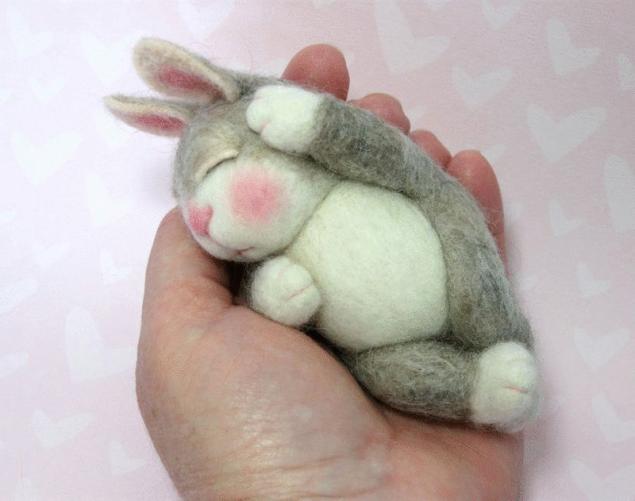
There is another technique of felting. You will need wool and a special needle with notches. Roll up a small ball of fur with your palms and carefully poke it with a needle. Very quickly the wool will start to harden. In this way most often make toys, brooches and keychains. Oshibana
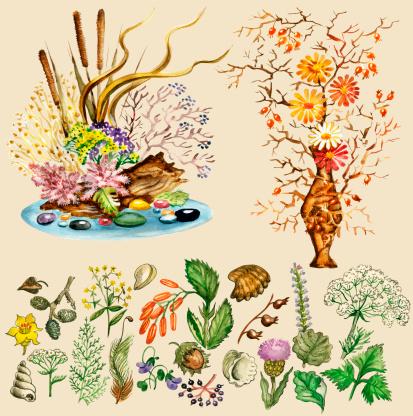
The collection of herbarium – one of the favorite autumn tasks for school teachers. But few know that in ancient Japan more than 600 years ago, pressed flowers worked hard men –the samurai. That's what today is called the ancient art of "oshibana" –the creation of paintings out of dried plants. Oshibana was a necessary step on the way of the warrior. It was believed that the art of selecting and sticking of parts of plants and flowers requires the same concentration as the ability to wield a sword. To create the paintings needed to be able to be "here and now", without being distracted by thoughts, dreams and memories. And only felt complete silence, you could feel the connection with nature and find the perfect location to dried plants on paper. For extruded floristry you will need a sheet of drawing paper, glue and patience. And attention to the nature around. Before you can create a picture, you will need to collect and dry under the pressure of any parts of plant: flowers, leaves, shoots. You will then be able to put them on a sheet of paper still lifes, landscapes and even portraits. The main condition – not to use when creating masterpieces with scissors. Japanese professionals can enjoy his works through the glass, from which pumped the air, but without vacuum, these pictures are stored for a very long time, if not to put them under direct sunlight. A delicious moment
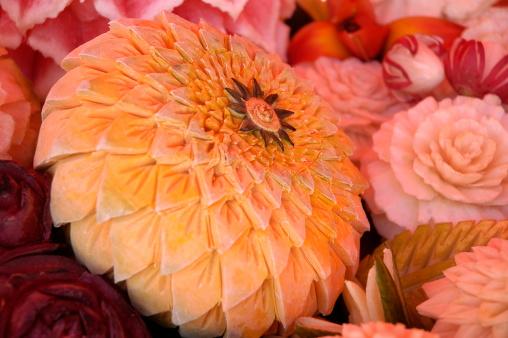
Another art which emerged in Europe from the East, carving, curly cutting fruits and vegetables. Professionals believe that the main thing for this hobby not skill, and respect for the creativity of nature. After all, before cutting apples or potatoes, the finest picture you need to see. In Thailand, the homeland of the carving, most cut orchids and flower arrangements, and in Japan and China love the characters and the dragons. However, for the class "edible" hobby does not have to be a professional Carver. Food art – the ability to see beauty in usual things – not less environmentally friendly and requires no special knowledge. Everything you need to create paintings of food, the attention, the ability to admire the world around us and wonder at him. For mom from Malaysia Samantha Lee food art began with attempts to teach your daughters to have a useful food. To every dinner she laid out on the plate funny scenes with your favorite cartoon characters of cereals, vegetables and fruits. Now the same pictures of pictures of food delight in admirers of her art. Ecodesigner Dan Cretu has created a series of sculptures of Food Objects on the basis of organic vegetables and fruits. The painter from Shanghai Hong Lee made the project "31 days of creativity with food" using only white plate is the canvas and the food instead of paint. As a Buddhist Katie Klein, mindful of the wheel of samsara, spreads, vegetables and leaves colorful mandala for meditation. Simple, tasty and very beautiful. Soap fantasy
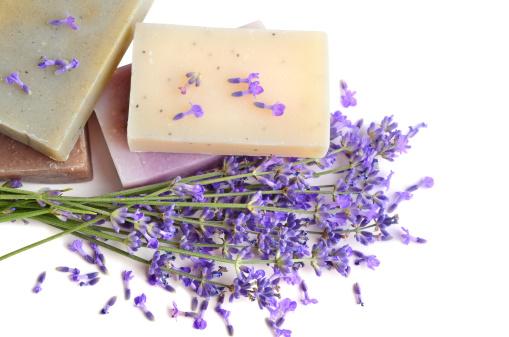
Why make soap yourself, if the store sells dozens of varieties? Fans of home soap making believe that natural soap contains more useful care skin supplements, natural flavors, and yet it is not harmful to the ecology of parabens and sulfates. All this is true, but to be honest, most people enjoys making handmade soap not health care, but for the sake of the creative process. Soap hand-made you can cook from scratch from lye, vegetable or animal oils, and you can create masterpieces using the so-called "soap base" – finished soap mass, which is sold at stores for soap makers. All other additions depend only on your imagination. In soap you can add essential oil, flowers and herbal teas, special paper with drawings, wine and beer, felt and ground coffee. Color soap, colored or natural food dyes, can be spread to form layers, and if you use a wide palette of colors, the soap, until it is not frozen, you can even draw. But if the soap seems too complicated, take manufacturing homemade cosmetics. Of soda, citric acid, sea salt and a few drops of essential oils are easy to make fizzy bombs for your bath. For a gentle cream tiles for the skin, you need oil, wax and fridge, and ground coffee, brown sugar and olive oil will make a perfect homemade scrub. published
Source: think-blue.ru

Japanese designer, Masahiro Mine has created a series of products for children Uchinoco of the conventional corrugated cardboard. Houses and tractors almost life-size, toys and beds assembled like origami from the cardboard, which in our country is most often used for the production boxes. Masahiro not alone in his fondness for this unusual material. American design firm has developed a series of furniture SmartDeco for lovers of frequent travellers: dresser, Desk, chair, shelves and a bookcase. This furniture can withstand weight up to 180 kg and carry it can be disassembled and folded stack. The manufacture of cardboard furniture is not a difficult task as it might seem at first glance. Start simple: watch, box, house for cats, a stool for the kitchen... on the Internet there are communities of fans of cardboard products on their sites already collected a large number of patterns and layouts of furniture for every taste. Cardboard is a durable material, and if it is painted with acrylic paints, paste and decorate, you will become the owner of a unique interior. In the world is used daily by so many packaging materials, including cardboard is one of the first places that a cardboard hobby can be considered one of the most environmentally friendly in our ranking. Warm world

Wool, soap and water is all you need for felting classes. Do you think that are not familiar with this kind of needlework? Then remember the most ordinary boots. The name of this Shoe, which, by the way, for several consecutive years, appearing on the fashion runways, is derived from the word "play". And for its production uses the famous technique of felting – felting-wet. Natural sheep wool is put on pre-cut layout, richly moistened with soapy water, then twist, RUB hands, and even beaten. While wool hairs, which under a microscope look like the trunk of a palm tree, twisted with each other and cling tightly to each other, forming a monolithic fabric – felt. According to legend, the first felt carpet appeared on Noah's ark. With sheep, which were in the stalls of the ark, on the floor, falling hair, there she was wet, and the animals their hooves hit her in the thick carpet. Like it or not, is unknown, but the most ancient felt carpets, found by archaeologists date back to V century BC. In fact, the description of the felting more complicated than the process itself. Even beginners will be able during the evening to create a "wet" technique felted beads that can be assemble into a necklace or bracelet, a flower and even a small rug or a scarf.

There is another technique of felting. You will need wool and a special needle with notches. Roll up a small ball of fur with your palms and carefully poke it with a needle. Very quickly the wool will start to harden. In this way most often make toys, brooches and keychains. Oshibana

The collection of herbarium – one of the favorite autumn tasks for school teachers. But few know that in ancient Japan more than 600 years ago, pressed flowers worked hard men –the samurai. That's what today is called the ancient art of "oshibana" –the creation of paintings out of dried plants. Oshibana was a necessary step on the way of the warrior. It was believed that the art of selecting and sticking of parts of plants and flowers requires the same concentration as the ability to wield a sword. To create the paintings needed to be able to be "here and now", without being distracted by thoughts, dreams and memories. And only felt complete silence, you could feel the connection with nature and find the perfect location to dried plants on paper. For extruded floristry you will need a sheet of drawing paper, glue and patience. And attention to the nature around. Before you can create a picture, you will need to collect and dry under the pressure of any parts of plant: flowers, leaves, shoots. You will then be able to put them on a sheet of paper still lifes, landscapes and even portraits. The main condition – not to use when creating masterpieces with scissors. Japanese professionals can enjoy his works through the glass, from which pumped the air, but without vacuum, these pictures are stored for a very long time, if not to put them under direct sunlight. A delicious moment

Another art which emerged in Europe from the East, carving, curly cutting fruits and vegetables. Professionals believe that the main thing for this hobby not skill, and respect for the creativity of nature. After all, before cutting apples or potatoes, the finest picture you need to see. In Thailand, the homeland of the carving, most cut orchids and flower arrangements, and in Japan and China love the characters and the dragons. However, for the class "edible" hobby does not have to be a professional Carver. Food art – the ability to see beauty in usual things – not less environmentally friendly and requires no special knowledge. Everything you need to create paintings of food, the attention, the ability to admire the world around us and wonder at him. For mom from Malaysia Samantha Lee food art began with attempts to teach your daughters to have a useful food. To every dinner she laid out on the plate funny scenes with your favorite cartoon characters of cereals, vegetables and fruits. Now the same pictures of pictures of food delight in admirers of her art. Ecodesigner Dan Cretu has created a series of sculptures of Food Objects on the basis of organic vegetables and fruits. The painter from Shanghai Hong Lee made the project "31 days of creativity with food" using only white plate is the canvas and the food instead of paint. As a Buddhist Katie Klein, mindful of the wheel of samsara, spreads, vegetables and leaves colorful mandala for meditation. Simple, tasty and very beautiful. Soap fantasy

Why make soap yourself, if the store sells dozens of varieties? Fans of home soap making believe that natural soap contains more useful care skin supplements, natural flavors, and yet it is not harmful to the ecology of parabens and sulfates. All this is true, but to be honest, most people enjoys making handmade soap not health care, but for the sake of the creative process. Soap hand-made you can cook from scratch from lye, vegetable or animal oils, and you can create masterpieces using the so-called "soap base" – finished soap mass, which is sold at stores for soap makers. All other additions depend only on your imagination. In soap you can add essential oil, flowers and herbal teas, special paper with drawings, wine and beer, felt and ground coffee. Color soap, colored or natural food dyes, can be spread to form layers, and if you use a wide palette of colors, the soap, until it is not frozen, you can even draw. But if the soap seems too complicated, take manufacturing homemade cosmetics. Of soda, citric acid, sea salt and a few drops of essential oils are easy to make fizzy bombs for your bath. For a gentle cream tiles for the skin, you need oil, wax and fridge, and ground coffee, brown sugar and olive oil will make a perfect homemade scrub. published
Source: think-blue.ru
Delightful eco-friendly sculptures from Sara Renzulli, made in the technique of needle felting
Eco-house with negative energy consumption
